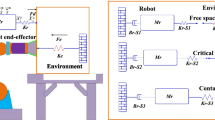Abstract
Stiffness adjustment is an important feature of human arm control. The adaptive variable impedance control can adapt to the robotic stiffness, but may result in a large overshoot. In this paper, nonlinear impedance control is proposed for collaborative robotic grinding, where nonlinear force feedback is designed to compensate for the nonlinear stiffness of the environment. Thus, the interaction system can be linearization to ensure the system stability. Moreover, a target trajectory adaptation strategy is studied to ensure the force tracking requirement. Then, switching law between trajectory tracking and force tracking is proposed when the robot performs a complex grinding task. The stability of the switch control as well as the trajectory adaptation law is proved. Experiments are conducted in a robotic grinding test rig, where the robot is used to grind a turbine blade. Experimental results show that the nonlinear impedance control can obtain stable grinding force, and have better grinding quality than the linear impedance control.
Similar content being viewed by others
References
Tao B, Zhao X W, Ding H. Mobile-robotic machining for large complex components: A review study. Sci China Tech Sci, 2019, 62: 1388–1400
Zhu D, Feng X, Xu X, et al. Robotic grinding of complex components: A step towards efficient and intelligent machining–challenges, solutions, and applications. Robotics Comput-Integrated Manuf, 2020, 65: 101908
Zhu Z, Tang X, Chen C, et al. High precision and efficiency robotic milling of complex parts: Challenges, approaches and trends. Chin J Aeronautics, 2021, 35: 22–46
Schindlbeck C, Haddadin S. Unified passivity-based cartesian force/impedance control for rigid and flexible joint robots via task-energy tanks. In: Proceedings of 2015 IEEE International Conference on Robotics and Automation (ICRA). IEEE, 2015. 440–447
El Helou M, Mandt S, Krause A, et al. Mobile robotic painting of texture. In: Proceedings of 2019 International Conference on Robotics and Automation (ICRA). IEEE, 2019. 640–647
Mohammad A E K, Hong J, Wang D. Design of a force-controlled end-effector with low-inertia effect for robotic polishing using macromini robot approach. Robotics Comput-Integrated Manuf, 2018, 49: 54–65
Ochoa H, Cortesao R. Impedance control architecture for robotic-assisted mold polishing based on human demonstration. IEEE Trans Ind Electron, 2021, 69: 3822–3830
Wang Q, Wang W, Zheng L, et al. Force control-based vibration suppression in robotic grinding of large thin-wall shells. Robotics Comput-Integrated Manuf, 2021, 67: 102031
Xu X, Zhu D, Zhang H, et al. Application of novel force control strategies to enhance robotic abrasive belt grinding quality of aeroengine blades. Chin J Aeronautics, 2019, 32: 2368–2382
Dyck M, Sachtler A, Klodmann J, et al. Impedance control on arbitrary surfaces for ultrasound scanning using discrete differential geometry. IEEE Robot Autom Lett, 2022, 7: 7738–7746
Navvabi H, Markazi A H D. Hybrid position/force control of stewart manipulator using extended adaptive fuzzy sliding mode controller (E-AFSMC). ISA Trans, 2019, 88: 280–295
Hogan N. Impedance control: An approach to manipulation: Part II— Implementation. J Dyn Syst Meas Contr, 1985, 107: 8–16
Zhao X, Tao B, Qian L, et al. Asymmetrical nonlinear impedance control for dual robotic machining of thin-walled workpieces. Robotics Comput-Integrated Manuf, 2020, 63: 101889
Zhao X, Han S, Tao B, et al. Model-based actor–Critic learning of robotic impedance control in complex interactive environment. IEEE Trans Ind Electron, 2021, 69: 13225–13235
Cremer S, Das S K, Wijayasinghe I B, et al. Model-free online neuroadaptive controller with intent estimation for physical human–robot interaction. IEEE Trans Robot, 2019, 36: 240–253
Sun T, Peng L, Cheng L, et al. Composite learning enhanced robot impedance control. IEEE Trans Neural Netw Learn Syst, 2019, 31: 1052–1059
Li Y, Ganesh G, Jarrasse N, et al. Force, impedance, and trajectory learning for contact tooling and haptic identification. IEEE Trans Robot, 2018, 34: 1170–1182
Burdet E, Osu R, Franklin D W, et al. The central nervous system stabilizes unstable dynamics by learning optimal impedance. Nature, 2001, 414: 446–449
Kana S, Tee K P, Campolo D. Human–robot co-manipulation during surface tooling: A general framework based on impedance control, haptic rendering and discrete geometry. Robotics Comput-Integrated Manuf, 2021, 67: 102033
Yang C, Zeng C, Liang P, et al. Interface design of a physical human–robot interaction system for human impedance adaptive skill transfer. IEEE Trans Automat Sci Eng, 2017, 15: 329–340
Yang C, Zeng C, Fang C, et al. A dmps-based framework for robot learning and generalization of humanlike variable impedance skills. IEEE ASME Trans Mechatron, 2018, 23: 1193–1203
He W, Dong Y, Sun C. Adaptive neural impedance control of a robotic manipulator with input saturation. IEEE Trans Syst Man Cyber Syst, 2015, 46: 334–344
Ficuciello F, Villani L, Siciliano B. Variable impedance control of redundant manipulators for intuitive human–robot physical interaction. IEEE Trans Robot, 2015, 31: 850–863
Dong Y, Ren B. UDE-based variable impedance control of uncertain robot systems. IEEE Trans Syst Man Cyber Syst, 2017, 49: 2487–2498
Saldarriaga C, Chakraborty N, Kao I. Damping selection for cartesian impedance control with dynamic response modulation. IEEE Trans Robot, 2021, 38: 1915–1924
Zhai A, Zhang H, Wang J, et al. Adaptive neural synchronized impedance control for cooperative manipulators processing under uncertain environments. Robotics Comput-Integrated Manuf, 2022, 75: 102291
Wang G, Deng Y, Zhou H, et al. PD-adaptive variable impedance constant force control of macro-mini robot for compliant grinding and polishing. Int J Adv Manuf Technol, 2023, 124: 2149–2170
Branicky M S. Stability of hybrid systems: State of the art. In: Proceedings of the 36th IEEE Conference on Decision and Control. IEEE, 1997. 120–125
Seraji H, Colbaugh R. Force tracking in impedance control. Int J Robotics Res, 1997, 16: 97–117
Author information
Authors and Affiliations
Corresponding author
Additional information
This work was supported by the National Key Research and Development Program of China (Grant No. 2022YFB4702200) and the National Natural Science Foundation of China (Grant Nos. 52275020, 62293514).
Rights and permissions
About this article
Cite this article
Han, F., Tam, S., Cao, Z. et al. Nonlinear impedance control with trajectory adaptation for collaborative robotic grinding. Sci. China Technol. Sci. 66, 1928–1936 (2023). https://doi.org/10.1007/s11431-022-2418-4
Received:
Accepted:
Published:
Issue Date:
DOI: https://doi.org/10.1007/s11431-022-2418-4




